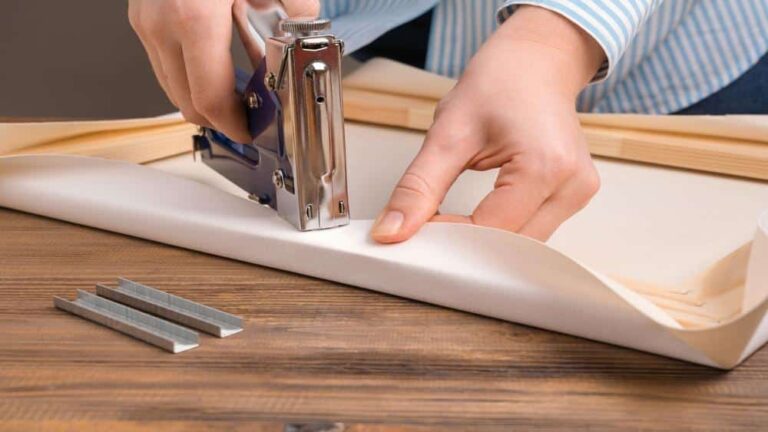The Dewalt Utility Knife is a versatile tool that finds its place in the toolkit of many professionals and DIY enthusiasts. Whether you’re a tradesperson, a craftsman, or a homeowner tackling various projects, the ability to change the blade on your Dewalt Utility Knife is a fundamental skill to have. In this “How to change blade on Dewalt utility knife” comprehensive guide, we will walk you through the step-by-step process of changing the blade on your Dewalt Utility Knife.
A sharp and reliable blade is essential for precise and efficient cutting, ensuring that your utility knife remains a trusted companion for various tasks. However, it’s necessary to approach blade replacement with the proper knowledge and safety precautions in mind.
We will not only cover the basic steps of blade replacement but also delve into essential safety measures, the tools and materials you’ll need, and how to address any challenges that may arise during the process. Additionally, we’ll provide maintenance tips to keep your Dewalt Utility Knife in optimal condition and troubleshoot common issues that you might encounter.
By the end of this guide, you’ll be equipped with the expertise to confidently change the blade on your Dewalt Utility Knife, ensuring that it remains a reliable tool in your arsenal. So, let’s get started on this journey of learning how to maintain and make the most of your Dewalt Utility Knife.

Introduction
Blade replacement in your Dewalt Utility Knife is a fundamental aspect of maintaining this essential tool. Understanding how to change the blade is not only a matter of convenience but also a crucial safety consideration. In this guide, we’ll delve into the importance of blade replacement and provide you with the know-how to carry out this task effectively.
Why Blade Replacement is Important
Changing the blade on your Dewalt Utility Knife is a routine maintenance task that offers several significant benefits:
- Safety: A sharp blade cuts more efficiently and reduces the risk of slips and accidents. Regular blade replacement ensures that your utility knife remains safe to use.
- Efficiency: A dull blade can make your cutting tasks more challenging and time-consuming. By changing the blade when it becomes dull, you can work more efficiently.
- Clean Cuts: A sharp blade produces clean and precise cuts, which is essential for various applications, from DIY projects to professional work.
- Longevity: Proper blade replacement and maintenance can extend the lifespan of your Dewalt Utility Knife. This saves you money in the long run by avoiding the need for frequent replacements.
- Versatility: Different tasks may require different blade types. Knowing how to change the blade allows you to adapt your utility knife for various cutting needs.
In the following sections, we’ll provide step-by-step instructions on how to change the blade on your Dewalt Utility Knife, ensuring that you can continue to use this versatile tool safely and effectively.
Now, let’s dive into the detailed process of blade replacement.
Safety Precautions
When it comes to changing the blade on your Dewalt Utility Knife, safety should always be a top priority. Following suitable safety precautions can help prevent accidents and ensure a smooth blade replacement process. Here are some essential safety measures to consider:
Protective Gear
- Safety Glasses: Before you begin, put on safety glasses to protect your eyes from any potential debris or metal shavings that may occur during the blade replacement.
- Gloves: Wear durable work gloves to safeguard your hands from sharp edges and prevent accidental cuts.
Workspace Setup
- Clear Workspace: Ensure your workspace is clutter-free and well-lit. A clean area reduces the chances of tripping or knocking objects onto the floor.
- Stable Surface: Work on a stable and flat surface to maintain control over your utility knife during the blade replacement process.
- Secure the Knife: Before changing the blade, retract the existing one fully and engage any safety mechanisms provided by your specific Dewalt Utility Knife model.
- Read Instructions: Always consult the manufacturer’s instructions or user manual that came with your utility knife. Different models may have unique blade replacement procedures.
By following these safety precautions, you can minimize risks and perform a successful blade change on your Dewalt Utility Knife. Safety should never be compromised when working with sharp tools, so take your time and prioritize protective measures.
Tools and Materials
Before you embark on changing the blade of your Dewalt Utility Knife, it’s essential to gather the necessary tools and materials to ensure a smooth and efficient process. Here’s what you’ll need:
What You’ll Need
- Dewalt Utility Knife: Ensure you have your Dewalt Utility Knife on hand, as this is the tool you’ll be working on.
- Replacement Blades: Depending on how many blade changes you plan to make, have an adequate supply of replacement blades ready. Ensure they are compatible with your specific Dewalt Utility Knife model.
- Safety Glasses: Protect your eyes from any debris or metal shavings that may be produced during the blade replacement process.
- Work Gloves: Wear durable work gloves to safeguard your hands from sharp edges and reduce the risk of cuts.
- Flat, Stable Surface: Find a flat and stable surface to work on, ensuring that your workspace is clutter-free.
- User Manual: Refer to the user manual or manufacturer’s instructions that came with your Dewalt Utility Knife. Different models may have unique blade replacement procedures, so having the manual as a reference is valuable.
By gathering these essential tools and materials, you’ll be well-prepared to change the blade on your Dewalt Utility Knife safely and effectively. Having everything ready before you start will streamline the process and help you achieve the desired results without any hassles.
Resolving Blade Change Challenges
To address the reported difficulties, follow this comprehensive step-by-step guide to smoothly replace the blade in your Dewalt Premium Retractable Utility Knife:
- Step 1: Identify the blade change button.
- Step 2: Press and hold the button.
- Step 3: Slide out the old blade.
- Step 4: Insert the new blade.
- Step 5: Release the button.
Common Mistakes to Avoid
Avoiding common mistakes during the blade replacement process is crucial. Here are key pointers to ensure a flawless execution:
- Inadequate Button Press: Ensure a firm and sustained press on the blade change button to prevent misalignment.
- Proper Blade Alignment: Align the new blade correctly to avoid jamming issues during operation.
Maintenance Tips for Your Dewalt Utility Knife
Keeping Your Utility Knife Sharp
Maintaining the sharpness of your Dewalt Utility Knife is crucial for its performance. Here are some tips to keep it sharp:
- Regular Blade Inspection: Check the blade for signs of wear and tear. If you notice any nicks or dullness, it’s time to replace the blade.
- Proper Storage: Store your utility knife in a dry and clean environment. Moisture and debris can affect the blade’s sharpness.
- Blade Replacement: Follow the manufacturer’s instructions to change the blade when needed. A sharp blade is safer and more efficient.
- Blade Lubrication: Applying a small amount of lubricant to the blade can help maintain its sharpness. Be sure to wipe off any excess lubricant before using the knife.
- Safe Handling: Avoid using excessive force when cutting, as it can dull the blade faster. Let the sharp edge do the work.
Troubleshooting Common Issues
Even with proper maintenance, you may encounter some common issues with your Dewalt Utility Knife. Here are solutions to these problems:
- Blade Won’t Retract: If the blade doesn’t retract, make sure you’ve fully engaged the blade release mechanism. Clean any debris that may be obstructing the mechanism.
- Blade Keeps Popping Out: This can happen if the blade isn’t adequately secured. Ensure the blade is correctly inserted and locked in place according to the manufacturer’s instructions.
- Difficulty in Blade Change: If you find it hard to change the blade, check if you’re pressing the release button or lever correctly. Some models may have specific steps to follow.
- Blade Doesn’t Lock: If the blade doesn’t lock in place, inspect the locking mechanism for damage. Replace any damaged parts or contact the manufacturer for assistance.
By following these maintenance tips and troubleshooting solutions, you can ensure that your Dewalt Utility Knife remains in top working condition, providing you with reliable cutting performance.
Conclusion
In this How to change blade on Dewalt utility knife comprehensive guide, we’ve explored the steps to change the blade on your Dewalt Utility Knife. This knowledge is essential for anyone who uses this versatile tool regularly. Let’s summarize the key points and provide some final thoughts.
Summary
In this How to Change Blade on Dewalt Utility Knife comprehensive guide, However, it requires attention to detail and safety precautions. Here’s a quick recap:
- Prepare Your Utility Knife: Start by retracting the blade and ensuring that the knife is unplugged if it’s a corded model.
- Locate the Blade Release Mechanism: Understand the different parts of your utility knife, especially the blade release mechanism.
- Engage the Blade Release: Learn how to release the blade safely to prepare for replacement.
- Remove the Old Blade: Handle the old blade with care and dispose of it properly.
- Insert the New Blade: Align the new blade correctly and ensure proper placement.
- Lock the Blade in Place: Secure the new blade to prevent accidents during use.
- Test the Blade: Always test the blade to ensure it functions correctly and is securely in place.
Final Thoughts
Changing the blade on your Dewalt Utility Knife is a routine maintenance task that ensures the tool’s efficiency and safety. By following the steps outlined in this guide, you can confidently replace the blade and continue using your utility knife for various tasks.
Remember to prioritize safety throughout the process. Always wear appropriate protective gear, and handle both the old and new blades with caution. Regularly inspect your utility knife to ensure it’s in good working condition.
We hope this guide has been helpful to both beginners and experienced users of Dewalt Utility Knives. Now, you know how to maintain your tool and make blade changes with ease. Stay safe and enjoy the convenience of your Dewalt Utility Knife!





